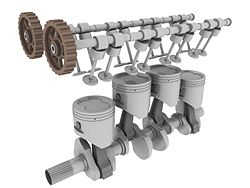Components
The valvetrain consists of all the components responsible for transferring the rotational movement of the camshaft into the opening and closing of the intake and exhaust valves. Typical components are listed below in order from the crankshaft to the valves.
Camshaft
The timing and lift profile of the valve opening events are controlled by the camshafts, through use of a carefully shaped lobe on a rotating shaft. The camshaft is driven by the crankshaft and, in the case of a four-stroke engine, rotates at half the speed of the crankshaft.
Motion is transferred from the crankshaft to the camshaft most commonly by a rubber timing belt, a metallic timing chain or a set of gears.
Pushrod
Pushrods are long, slender metal rods that are used in overhead valve engines to transfer motion from the camshaft (located in the engine block) to the valves (located in the cylinder head). The bottom end of a pushrod is mated to a lifter, upon which the camshaft makes contact. The camshaft lobe moves the lifter upwards, which moves the pushrod. The top end of the pushrod pushes on the rocker arm, which opens the valve.
Rocker arm / Finger / Bucket tappet
Depending on the design used, the valves are actuated by a rocker arm, finger, or bucket tappet. Overhead valve engines use rocker arms, which are actuated from below indirectly (through the pushrods) by the cam lobes. Overhead camshaft engines use fingers or bucket tappets, which are actuated from above directly by the cam lobes. [3]
Valves
Most modern engines use poppet valves, although sleeve valves, slide valves and rotary valves have also been used at times. Poppet valves are typically opened by the camshaft lobe or rocker arm, and closed by a coiled spring called a valve spring.
Valve float occurs when the valve spring is unable to control the inertia of the valvetrain at high engine speeds (RPM). [4] [5]
Valve guide
Valve guides ensure that engine valves are properly aligned, support the intake/exhaust valve stem, stabilize valve angle, and allow heat to escape to the cylinder head.
This page is based on this
Wikipedia article Text is available under the
CC BY-SA 4.0 license; additional terms may apply.
Images, videos and audio are available under their respective licenses.

